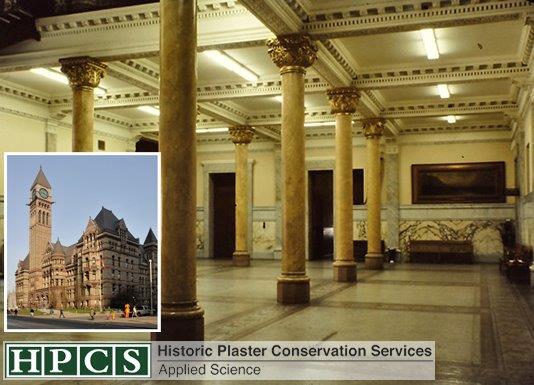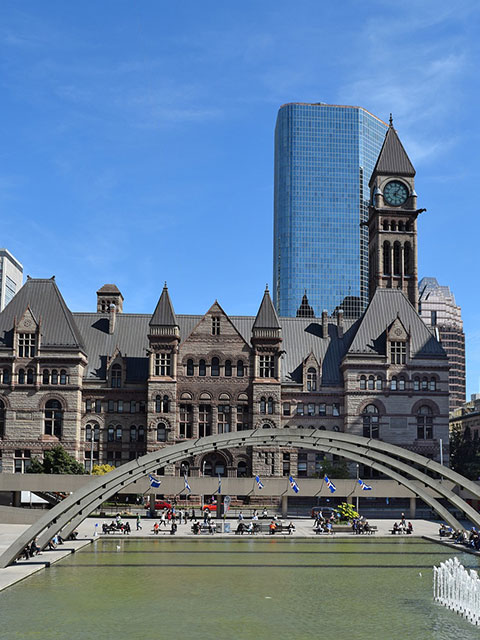Toronto, Ontario (1899)
The Building:
The Richardsonian Romanesque former City Hall is one of the largest buildings in Toronto and was the largest civic building in North America upon completion in 1899.
Consolidating Plaster from a Remote Location in 150 Rooms
The collapse of a section of office ceiling in 2006 precipitated an investigation by HPCS that revealed widespread delamination of wood lath and plaster ceilings in more than 300 rooms, many with elaborate plaster cornices and other details.
Interestingly, the architect, E.J. Lennox had chosen to use plaster on wood lath in offices and secondary spaces, and the more modern expanded metal lath on ceilings in public spaces and council chambers. The metal lath and plaster ceilings have held up beautifully. This became apparent in 2005 when HPCS, working with Chris Hall of +VG Architects, conducted a thorough investigation of all 415 ceilings in the building as part of the planning for a new HVAC system.

When the HVAC contract was completed, HPCS was asked to coordinate the conservation of the ceiling plaster. Trials were conducted, and HPCS was able to demonstrate a consolidation methodology successfully. Using an HPCS-designed Remote Consolidant Applicator (RCA) was a practical option to treat 150 of the most vulnerable and important heritage-designated ceilings in the building. The RCA distributes measured amounts of the appropriate acrylic resin in pre-determined shots through 1/4″ holes drilled at 6′ intervals across the ceiling. This is a very low level of intervention, particularly in light of the intensity and breadth of the treatment accomplished.
Cornices in these and other rooms were treated with another HPCS device – the Cornice Treatment Wand™. The development of these tools meant that measured amounts of evenly distributed consolidation primer and consolidation agent could, for the first time, be predictably and efficiently applied to the upper side of wood lath and plaster ceilings without the need to remove flooring in the room above.
Plaster consolidation of more than 50,000 sq. ft. of ceilings was ultimately carried out by members of the International Union of Painters and Allied Trades, who received special training from HPCS. Work was done only during the overnight hours when the building was closed, and each day, the spaces were returned to active use by the tenants. Historic Plaster Conservation Services provided quality control supervision and testing to ensure the efficacy of the treatments.
The project ran for over four years and was completed with consistent and excellent results, as evidenced by samples taken from the ceilings after treatment. Throughout this project, the building remained intensely occupied by the Attorney General of Ontario, with dozens of law courts operating seven days per week from 8:00 a.m. to 10 p.m.

